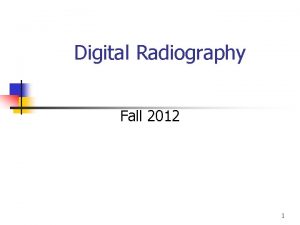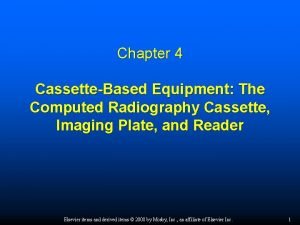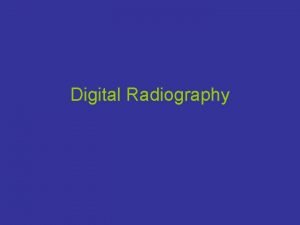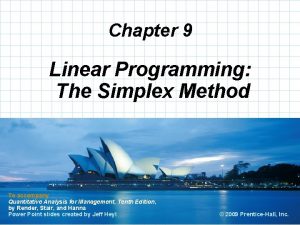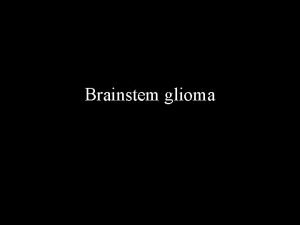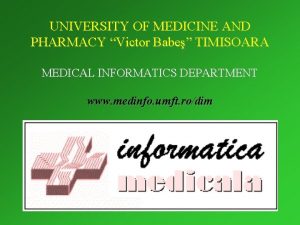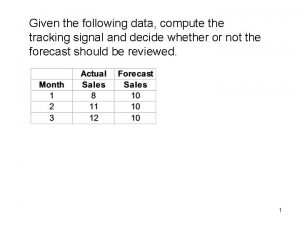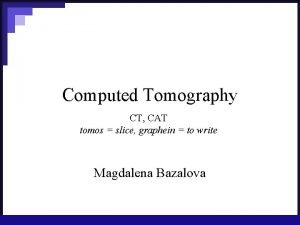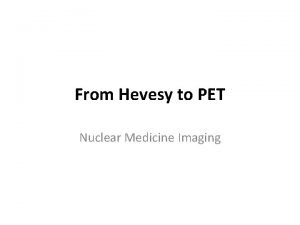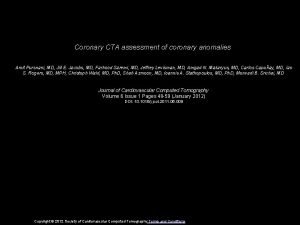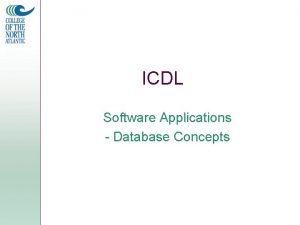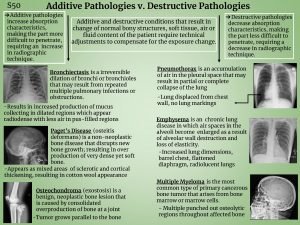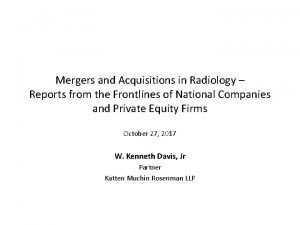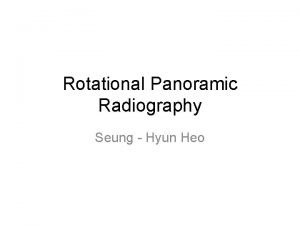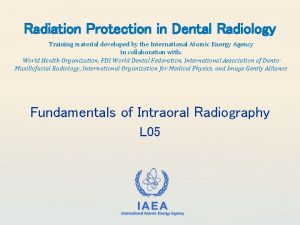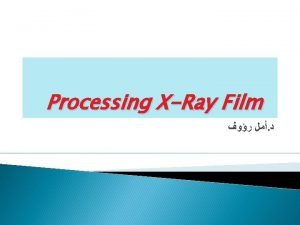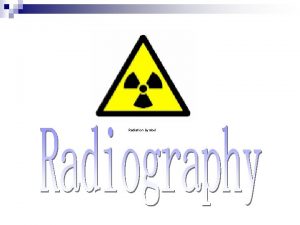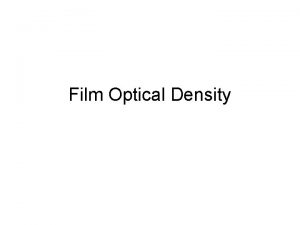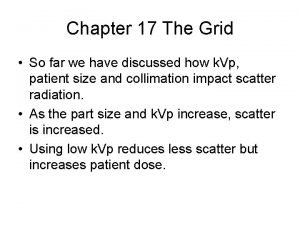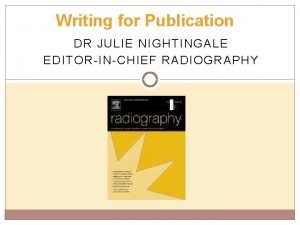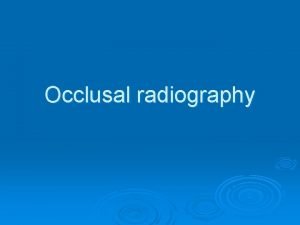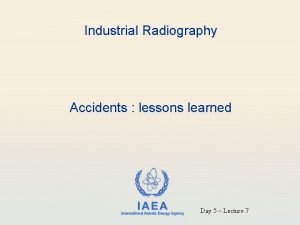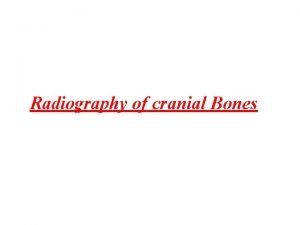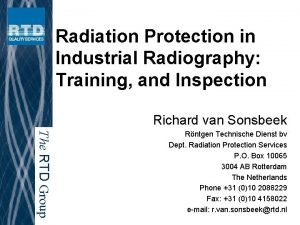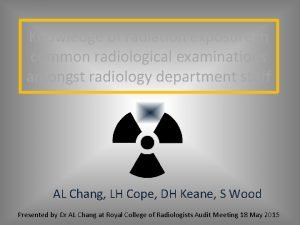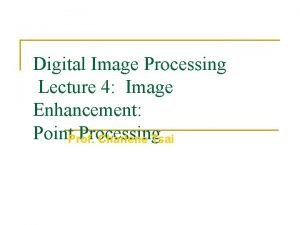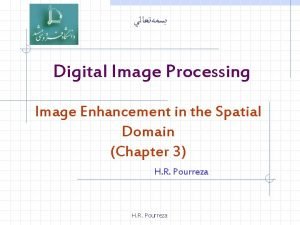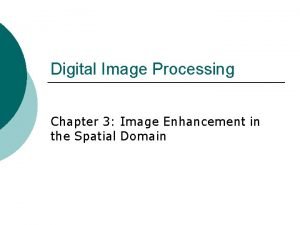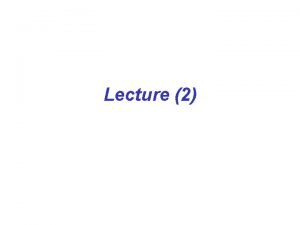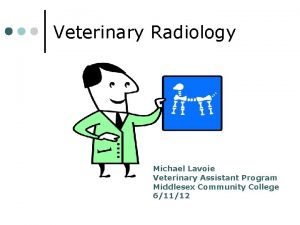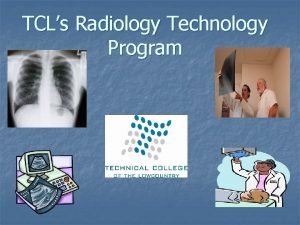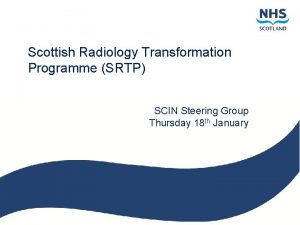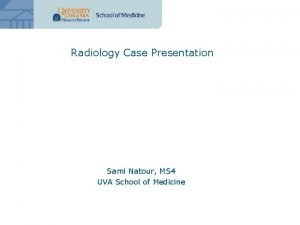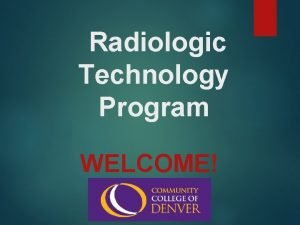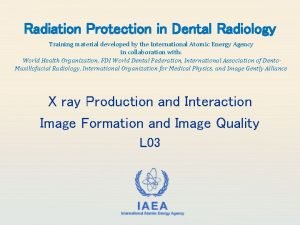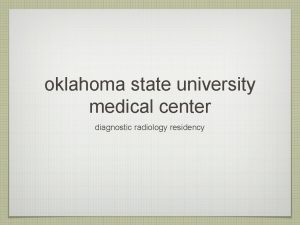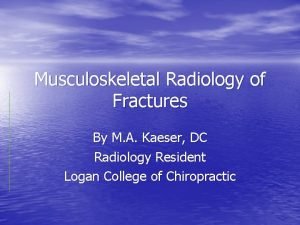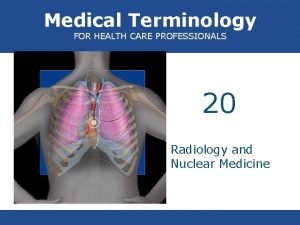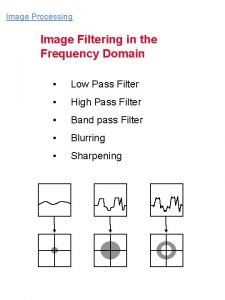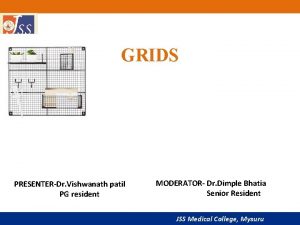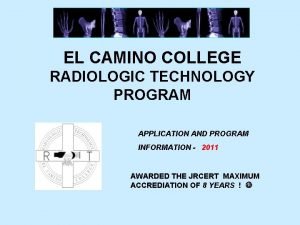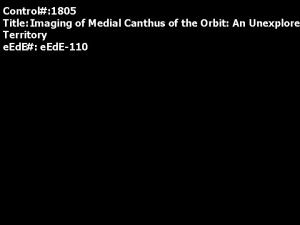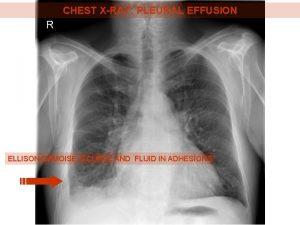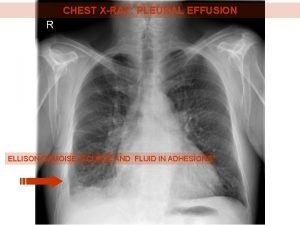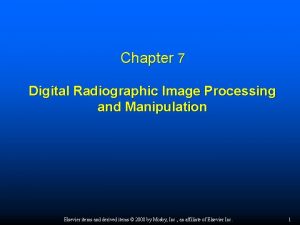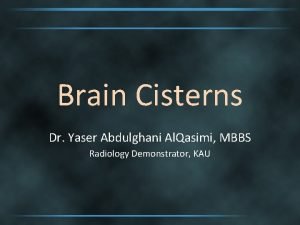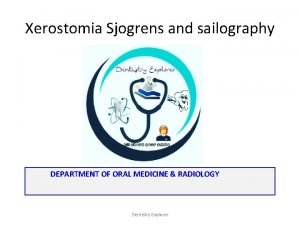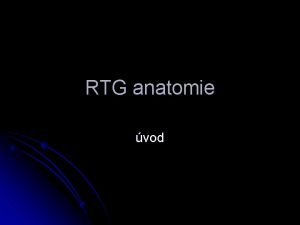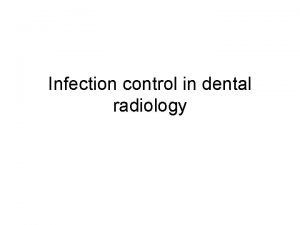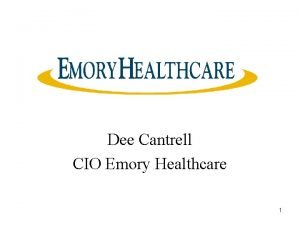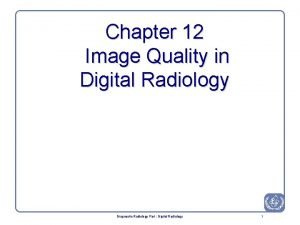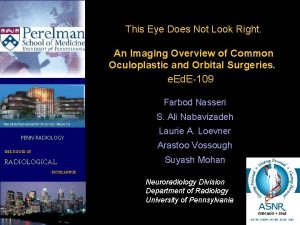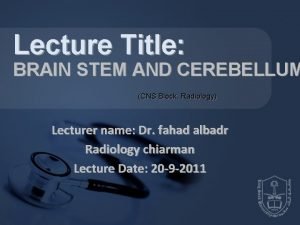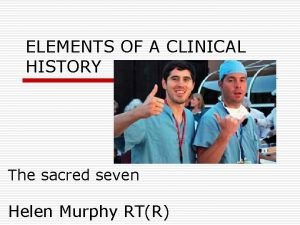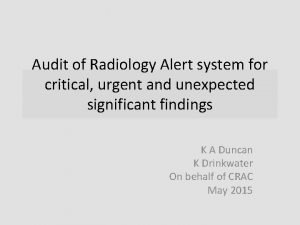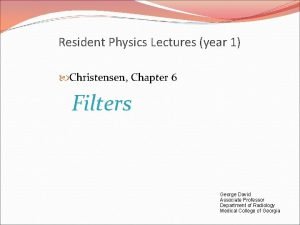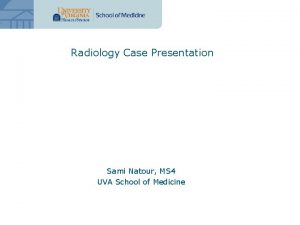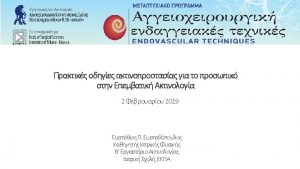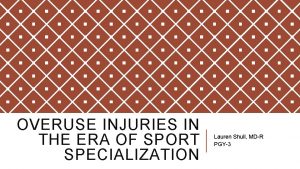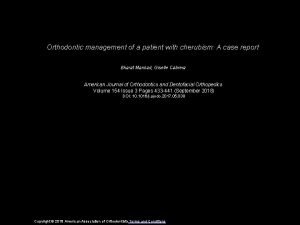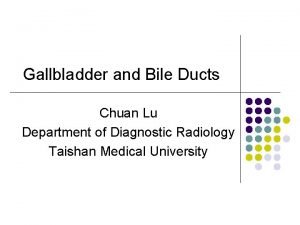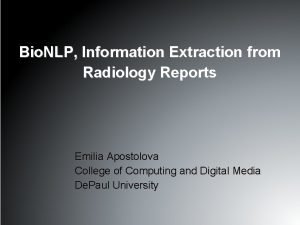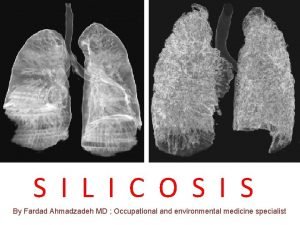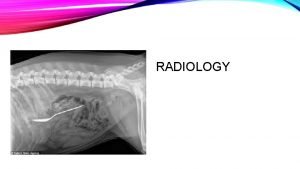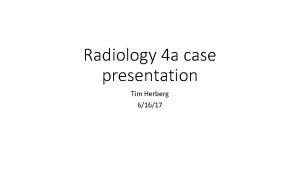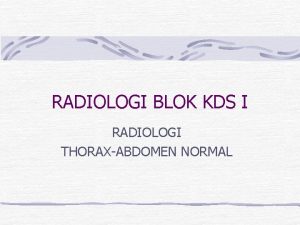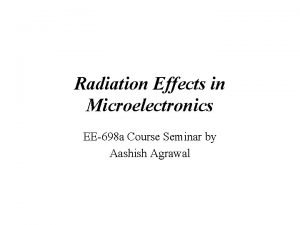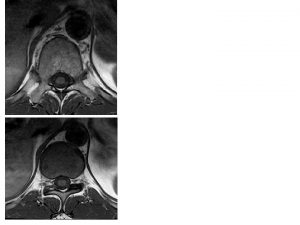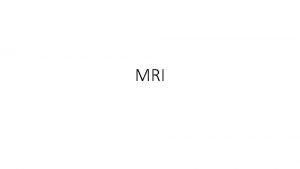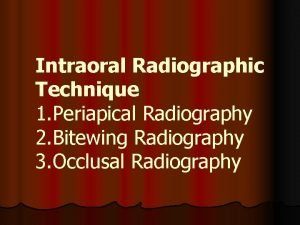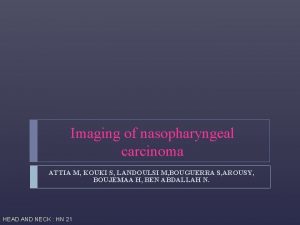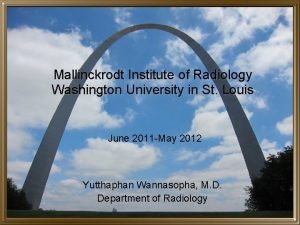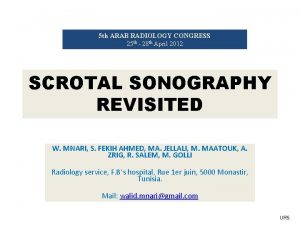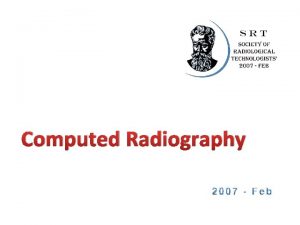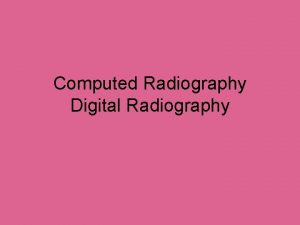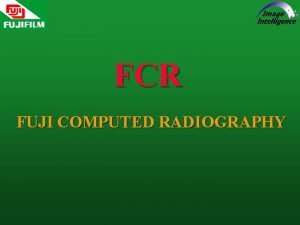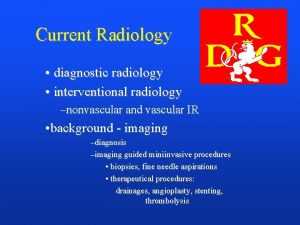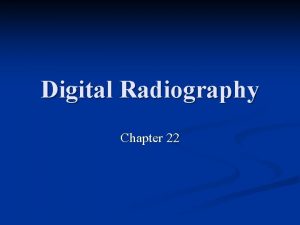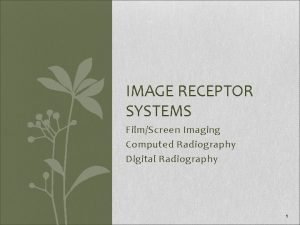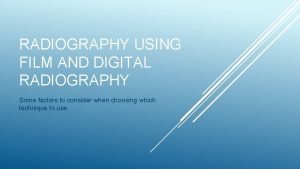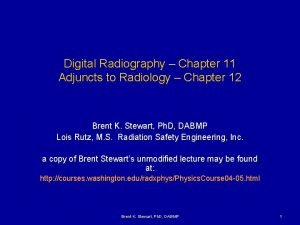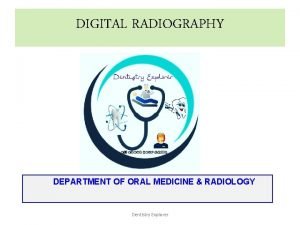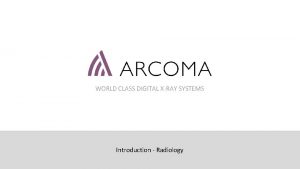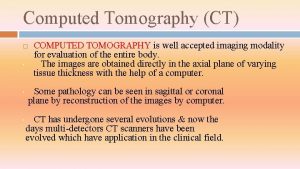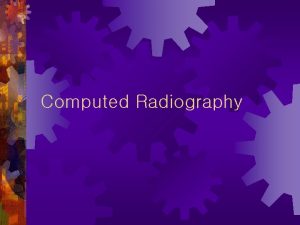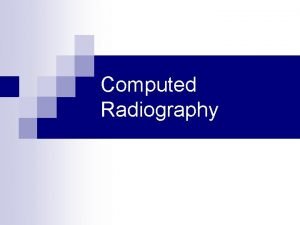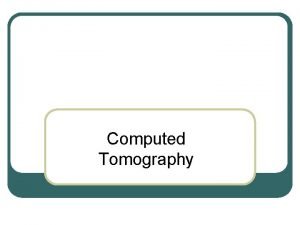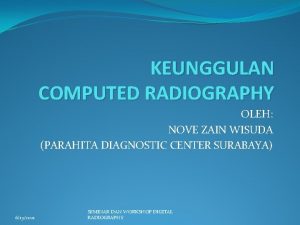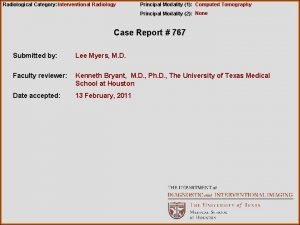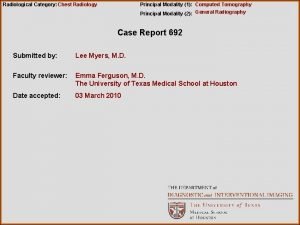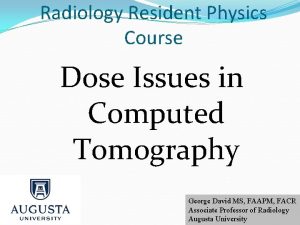Computed Radiography and Digital Radiography 1 filmless radiology
















































































































- Slides: 112

Computed Radiography and Digital Radiography 1

filmless’ radiology departments Diagnostic radiographers have traded their ______ and _____ for a _____ and _____ advance for Rad Sci Prof, 8/9/99 2

What Is Digital Imaging? Digital imaging is the acquisition of images to a computer rather than 3

New Technology n Has impacted everyone: 1. Practicing radiologic technologist 2. Educators 3. Administrators 4. Students in the radiologic sciences. 4

Computed Radiography Fundamentals of Computerized Radiography 5

Radiology 1895 Radiology 2001 6

CR SYSTEM COMPONENTS 1. CASSETTES (phosphor plates) 2. ID STATION 3. IMAGE PREVIEW (QC) STATION 4. DIGITIZER 5. VIEWING STATION 7

8

History of CR • • INDUSTRY Theory of “filmless radiography” first introduced in 1970 1981 Fugi introduced special cassettes with PSP plates (replaces film) • Technology could not support system • First clinical use in Japan - 1983 9

Predictions n n n 1980 – Bell Labs believed that Unix would be the worlds dominant operating system 1982 – Bill Gates thought 640 K of main memory would suffice for workplace operating systems ( This presentation is 80, 000 kb) 1984 – IBM predicted that personal computers would not amount to anything 10

History of CR n n n By 1998 – over 5, 000 CR systems in use nationwide 1998 – Local area hospitals begin to incorporate CR systems in their departments (Riverside Co. Hosp builds new hospital in Moreno Valley) – completely CR system – 1 st generation equipment 11


IMAGE CREATION n n SAME RADIOGRAPHY EQUIPMENT USED THE DIFFERENCE IS HOW IT IS 1. 2. 3. 4. ___________ 13

14

Conventional vs. Digital Imaging n Conventional X-ray imaging systems Produce an analog image (radiographs, & fluoroscopy). n Using x-ray tube with films & cassettes n 15

Conventional vs. Digital Imaging n n Digital radiography systems require that the electronic signal be converted to a digital signal – Using x-ray tube – n n CR cassettes with phosphor plate (PSP) DR systems with transistors (TFT) 16

COMPUTED RADIOGRAPHY & DIRECT RADIOGRAPHY & FILM SCREEN IMAGE CAPTURE FS - Film inside of cassette CR – Photostimuable Phosphor Plate (PSP) DR(DDR) - Thin Film Transitor (TFT) 17

Cassette with film CR with PSP 18

19

Directed Digital Radiography (DDR) Directed digital radiography, a term used to describe total electronic imaging capturing. Eliminates the need for an image plate altogether. 20

21

Amorphous Selenium detector technology for DR Direct Radiography 22

23

24

IMAGE CAPTURE _______ 1. n n PSP – photostimulable phosphor plate Replaces film in the cassette _______ – No cassette- 2. n n Photons captured directly onto TFT Sent directly to a monitor 25

CR vs. FS FILM n Film in cassette n loaded in a darkroom n Processed in a processor CR n PSP in cassette n Digital image n Scanned & read- CR reader FILM n Hard copy image – stores the image n Viewboxes – view the images COMPUTER n Image stored on computer n Viewed on a Monitor n Hard copy (film) can be made with laser 26 printer

CR BASICS • Eliminates the need for film as a recording, storage & viewing medium. • PSP Plate – receiver • Archive Manager – storage • Monitor - Viewing 27

General Overview CR PSP cassette exposed by conventional X-ray equipment. n n Latent image generated as a matrix of trapped electrons in the plate. 28

CR – PSP plate 1. Photostimulable phosphor (PSP) plate 2. Captures photons 3. Stored in traps on plate (latent image) 4. PLATE scanned in CR READER 29

CR Phosphor Plates ABSORPTION EMISSION LASER STIMULATION X-RAY ELECTRON TRAP LIGHT 30

CR – PSP plate 1. 2. 3. 4. Stimulated by a ________ LIGHT Energy is ____ in a form of _____ light LIGHT captured by photomultiplier tube (PMT) 31 Changed to a _________ signal

How CR works 1. 2. 3. Blue released light is captured by a PMT (photo multiplier tube) This light is sent as a digital signal to the computer The intensity _____ of the light – correlates to the ______ on the image 32

33

34

35

CR “PROCESSORS” 36

Densities of the IMAGE 1. The light is proportional to amount of light received 2. Digital values are then equivalent (not exactly the same) to a value of optical density (OD) from a film, at that location of the image 37

38

39

ERASING PLATE 1. 2. 3. After image is recorded Plate is erased with high intensity ____________ light Cassettes are reused 40

CR VS. DR n n CR -_______ where the image is first captured on plate and stored = then converted to digital signal DDR -______ where the image is acquired immediately as a matrix of pixels – sent to a monitor 41

Digital Radiography Direct Capture Direct-to-Digital Radiography (DDR) Indirect Capture Computed Radiography (CR) 42

DIRECT RADIOGRAPHY n Uses a transistor receiver (like bucky) n n n Captures and converts x-ray energy directly into digital signal Images seen immediately on monitor Sent to PACS/ printer/ other workstations FOR VIEWING 43

CR vs DR CR n Imaging plate n n n DR n Transistor receiver (like bucky) Processed in a Digital Reader n Signal sent to computer n Directly into digital signal Seen immediately on monitor Viewed on a monitor 44

45

Image Resolution – (how sharply is the image seen) CR • 4000 x 4000 • Image only as good a monitor* • 525 vs 1000 line • More pixels = more memory needed to store • CR 2 -5 lp/mm • RAD 3 -6 lp/mm • DR ? • IMAGE APPEARS SHARPER BECAUSE CONTRAST CAN BE ADJUSTED BY THE COMPUTER – • (DIFFERENCES IN DENSITY) 46

ADVANTAGE OF CR/DR n Can optimize image quality n Can manipulate digital data n Improves visualization of anatomy and pathology n AFTER EXPOSURE TO PATIENT 47

ADVANTAGE OF CR/DR n n Changes made to image after the exposure Can eliminate the need to repeat the exposure 48

ADVANTAGE OF CR/DR vs FS 1. Rapid storage 2. Retrieval of images NO LOST FILMS! 3. PAC (storage management) 4. 5. Teleradiology - long distance transmission of image information Economic advantage - at least in the long run? 49

CR/DR VS FILM/SCREEN 1. 2. 3. FILM these can not be modified once processed If copied – lose quality DR/CR – print from file – no loss of quality 50

“No fault” TECHNIQUES F/S: RT must choose technical factors (m. As & kvp) to optimally visualize anatomic detail CR: the selection of processing algorithms and anatomical regions controls how the acquired latent image is presented for display n HOW THE IMAGE LOOKS CAN BE ALTERED BY THE COMPUTER – EVEN WHEN “BAD” TECHNIQUES ARE SET 51

DR 1. Initial expense high 2. Very low dose to pt – 3. 4. Image quality of 100 s using a 400 s technique Therefore ¼ the dose needed to make the image 52

Storage /Archiving FILM/SCREEN 1. 2. 3. 4. CR & DR Films: bulky 1. Deteriorates over time 2. Requires large storage & expense Environmental concerns 3. 4. 8000 images stored on CD-R Jukebox CD storage No deterioration of images Easy access 53

54

Transmission of Images 1. 2. 3. ______ - Picture Archiving & Communications System ______- Digital Images & Communication in Medicine _____ -Remote Transmission of Images 55

56

Benefits of Computer (web)-based Viewing Systems 1. 2. 3. Hardcopy studies are no longer misplaced or lost- eliminates films Multiple physicians may access same patient films Patients do not have to wait in Radiology for films once study is completed 57

“Film-less” components 1. 2. 3. 4. CR or DR CD-ROM or similar output Email capability Digitizing capability or service 58

PACS Digital Images Archive Database and Workflow Engine Remote Facilities Internet VPN Workstations Remote Workstations 59

Histogram Analysis 1. 2. 3. A histogram is a plot of gray scale value vs. the frequency of occurrence (# pixels) of the gray value in the image 60

61

n n HISTOGRAM – a bar graph depicting the density distribution (in numerical values) of the imaging plate ALGORITHM – a set of mathematical values used to solve a problem or find an average 62

Adapted from AAPM TG 10 63

64

Statistical plots of the frequency of occurrence of each pixel's value 65

Basics of Digital Images n Digital images are a (matrix) of pixel (picture element) values 66

67

n The algorithm attempts to distinguish among the parts of the histogram which represent the range of densities from bone to soft tissue 68

n n n Histograms set for specific exams (body parts) Should produce digital images that are consistent (regardless of k. Vp or m. As used) Correct Algorithm (body part) must be selected prior to processing imaging plate 69

70

Methods to Digitize an Image 1. _____ - Teleradiography system (PACS, DICOM) 2. ____ (vidicon or plumbicon) 3. _______________ 4. _______________ 71

FILM DIGITIZER 72

Analog vs Digital 1. _______ _ - one value blends into another 1. 2. like a thermometer _______ - distinct separation 1. 2. 98. 6 exact 73

ANALOG TO DIGITAL IMAGE 1. 2. 3. Conversion of conventional analog films To digital format for PACs and teleradiology applications With scanning laser digitizers 74

CONTRAST & DENSITY Most digital systems are capable of 1024 shades of gray – 1. n 2. 3. but the human eye can see only about 30 shades of gray The Optical Density and Contrast can be adjusted after the exposure by the Radiographer. This is POST - PROCESSING 75

High displayed contrast – narrow window width 76

Low displayed contrast (stretched) – wide window width 77

Basics of Digital Images 1. 2. 3. Pixel values can be any bit depth (values from 0 to 1023) Image contrast can be manipulated to stretched or contracted to alter the displayed contrast. Typically use “window width” and “window level” to alter displayed contrast 78

79

80

80 KVP 5 5 100 30 15 200 500 81

n n n Then the COMPUTER corrects any exposure errors Therefore almost ANY technique can be used on the patient – The computer will fix it 82

DOSE IMPLICATIONS 1. 2. 3. 4. More exposure to the patient Techniques established Higher k. Vp = Less m. As Less patient dose 83

80 kvp 200 mas 10 mas 80 kvp Note Quantum Mottle 84

Dose Implications 1. 2. Images nearly always look better at higher exposures. Huge dynamic range means nearly impossible to overexpose. 85

POST PROCESSING 86

TECHNIQUE CONISDERATIONS 1. 2. 3. KVP Dependant Now COMPUTER controls CONTRAST Higher k. Vp to stimulate electron traps 87

standard image edge sharpening 88

REPROCESSED NO GRID HAND ALGO 89

QC – Reader (replaces Darkroom & Processor & Chemicals Diagnostic Viewer (replaces film, storage & viewboxes) 90

91

FILM SCREEN PROCESSOR 92

REPEAT IMAGES 93

94

EMERGING PROBLEMS 1. 2. Better – not necessarily faster Learning curve for technologists and physicians 3. Student applications and issues 4. Pitfalls of CR 95

96

1. 2. _____ and proper _____ are critical to good imaging outcomes Just like Phototiming, it can magnify your mistakes 97

COLLIMATION CRITICAL 1. 2. 3. As the computer reads the density value of each pixel- it is averaged into the total Close collimation= Better contrast Bad collimation= more grays and less detail 98

99

A B 100

101

102

103

104

1. 2. Digital imaging is not the end all, cure all for imaging problems It is still technologist dependent 105

To Produce Quality Images For Conventional Projection or CR Radiography: The same rules, theories, and laws still apply and can not be overlooked FFD/OFD (SID/SOD) Inverse Square Law Beam Alignment Tube-Part-Film Alignment Collimation Grids Exposure Factors: KVP, Ma. S Patient Positioning 106

107

108

CONVENTIONAL RADIOGRAPHY VIEWING OF “X-RAY FILM” IMAGES 109

• Towel that was used to help in positioning a child NEW IMAGE • CR is MORE sensitive to • ARTIFACTS 110

CR image – n NEW IMAGE Line caused from dirt collected in a CR Reader 111

High resolution with digital imaging 112
 Filmless radiography
Filmless radiography Computed radiography cassette
Computed radiography cassette Sulphonal casset
Sulphonal casset In simplex table the pivot row is computed by
In simplex table the pivot row is computed by Margin of safety in dollars
Margin of safety in dollars Computed tomography of the head
Computed tomography of the head Magnetic resonance timisoara
Magnetic resonance timisoara Hematome
Hematome A tracking signal is computed by
A tracking signal is computed by Ring artefact
Ring artefact Researchgate
Researchgate Journal of cardiovascular computed tomography
Journal of cardiovascular computed tomography A computed is a calculation that a dbms performs
A computed is a calculation that a dbms performs Data acquisition in ct
Data acquisition in ct Spectral matching radiography
Spectral matching radiography Soot and whitewash radiography
Soot and whitewash radiography Is osteoporosis additive or destructive
Is osteoporosis additive or destructive Isovue
Isovue Radiology mergers and acquisitions
Radiology mergers and acquisitions American academy of oral and maxillofacial radiology
American academy of oral and maxillofacial radiology Oral medicine and radiology day
Oral medicine and radiology day Digital market and digital goods
Digital market and digital goods Focal trough in panoramic radiography
Focal trough in panoramic radiography Grid ratio formula
Grid ratio formula Faulty radiographs
Faulty radiographs Latent image formation in radiography
Latent image formation in radiography Labial mounting
Labial mounting Radiography safety precautions
Radiography safety precautions Dry bench in dark room
Dry bench in dark room Radiography cordon off distance formula
Radiography cordon off distance formula Optical density formula
Optical density formula Types of grid cut off
Types of grid cut off Gurney mott theory of latent image formation
Gurney mott theory of latent image formation Industrial radiography accidents
Industrial radiography accidents Radiography
Radiography Lower 90 degree occlusal
Lower 90 degree occlusal Industrial radiography accidents
Industrial radiography accidents Rni radiography
Rni radiography Skull with wings
Skull with wings Industrial radiography training
Industrial radiography training Limitations of radiography
Limitations of radiography Buccal object rule
Buccal object rule Reverse towne projection
Reverse towne projection Mask mode radiography
Mask mode radiography The objective of sharpening spatial filter is to
The objective of sharpening spatial filter is to Chapter 3 image
Chapter 3 image Uretorocele
Uretorocele Msp meaning in radiography
Msp meaning in radiography Domestic short-haired cat
Domestic short-haired cat Stp competition ratios
Stp competition ratios Bryant triangle normal range
Bryant triangle normal range Tcl radiology program
Tcl radiology program Statdx radiology
Statdx radiology Scottish radiology transformation programme
Scottish radiology transformation programme Osh imaging
Osh imaging Ccd radiology
Ccd radiology Pa dental radiology ce requirements
Pa dental radiology ce requirements X ray protection
X ray protection Radiolysis of water ppt
Radiolysis of water ppt Curtis rad
Curtis rad Pnenumbra
Pnenumbra Osu radiology tulsa
Osu radiology tulsa Charcot joints
Charcot joints Radiology terminology
Radiology terminology Karisma ris
Karisma ris Band pass filter in image processing
Band pass filter in image processing Air gap technique in radiology
Air gap technique in radiology El camino rad tech
El camino rad tech Veterinary radiology dallas county
Veterinary radiology dallas county Medial canthus ct
Medial canthus ct Ellis curve radiology
Ellis curve radiology Ellis s shaped curve
Ellis s shaped curve Veil glare radiology
Veil glare radiology Ambient sistern
Ambient sistern Branchless fruit laden tree appearance seen in
Branchless fruit laden tree appearance seen in Basion opisthion line radiology
Basion opisthion line radiology Infection control in dental radiology
Infection control in dental radiology Emory healthcare virtual desktop
Emory healthcare virtual desktop Computational radiology
Computational radiology Radiology
Radiology Radiology asistant
Radiology asistant Vision radiology reservoir
Vision radiology reservoir Haudek niche
Haudek niche Bronkiektasis radiologi
Bronkiektasis radiologi Tennis elbow radiology
Tennis elbow radiology Cerebellum ct anatomy
Cerebellum ct anatomy Basic four sacred seven
Basic four sacred seven Radiology alert system
Radiology alert system Musined
Musined Inherent filtration radiology
Inherent filtration radiology Sami natour
Sami natour Radiology
Radiology Osgood schlatter radiology
Osgood schlatter radiology Cherubism radiology
Cherubism radiology Angiofibroma nasofaring juvenile radiology
Angiofibroma nasofaring juvenile radiology Diagnostic radiology department
Diagnostic radiology department Xxxxxdob
Xxxxxdob Prostate gland mri
Prostate gland mri What is silicos
What is silicos Next generation radiology
Next generation radiology Uva radiology tutorial
Uva radiology tutorial Sinus costophrenicus tumpul
Sinus costophrenicus tumpul Linear energy transfer in radiology
Linear energy transfer in radiology Tube shift technique
Tube shift technique Corpus callosum anatomy radiology
Corpus callosum anatomy radiology Empty notch sign radiology
Empty notch sign radiology Maxillary lateral occlusal projection
Maxillary lateral occlusal projection Blunning
Blunning Nonjtube
Nonjtube X ray mastoid towne's view position
X ray mastoid towne's view position Mallinckrodt institute of radiology
Mallinckrodt institute of radiology Monocacy health partners patient portal
Monocacy health partners patient portal Varicocele grading radiology assistant
Varicocele grading radiology assistant
